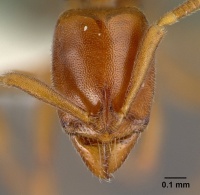Hypoponera odiosa
| Hypoponera odiosa | |
|---|---|

| |
| Scientific classification | |
| Kingdom: | Animalia |
| Phylum: | Arthropoda |
| Class: | Insecta |
| Order: | Hymenoptera |
| Family: | Formicidae |
| Subfamily: | Ponerinae |
| Tribe: | Ponerini |
| Genus: | Hypoponera |
| Species: | H. odiosa |
| Binomial name | |
| Hypoponera odiosa Bolton & Fisher, 2011 | |
Known only from Cameroon, specimens have been collected from lowland rainforest in mini winkler samples.
Identification
H. odiosa is extremely close to Hypoponera occidentalis and is mainly separated by subtle, but apparently consistent, details in the shape of the petiole node.
A member of the abeillei group.
Keys including this Species
Distribution
Latitudinal Distribution Pattern
Latitudinal Range: 5.6° to 3.2175°.
| North Temperate |
North Subtropical |
Tropical | South Subtropical |
South Temperate |
- Source: AntMaps
Distribution based on Regional Taxon Lists
Afrotropical Region: Cameroun (type locality).
Distribution based on AntMaps
Distribution based on AntWeb specimens
Check data from AntWeb
Countries Occupied
| Number of countries occupied by this species based on AntWiki Regional Taxon Lists. In general, fewer countries occupied indicates a narrower range, while more countries indicates a more widespread species. |

|
Estimated Abundance
| Relative abundance based on number of AntMaps records per species (this species within the purple bar). Fewer records (to the left) indicates a less abundant/encountered species while more records (to the right) indicates more abundant/encountered species. |

|
Biology
Castes
Queens are known but were not described with the workers. Males have not been collected.
Nomenclature
The following information is derived from Barry Bolton's Online Catalogue of the Ants of the World.
- odiosa. Hypoponera odiosa Bolton & Fisher, 2011: 80, figs. 88-90 (w.q.) CAMEROUN.
Unless otherwise noted the text for the remainder of this section is reported from the publication that includes the original description.
A single specimen recorded from Mbalmayo, (BMNH), appears to be intermediate between Hypoponera occidentalis and odiosa in most respects, but may represent a separate sibling species. It has a fairly conspicuous sharp, black denticle at the midpoint of the anterior clypeal margin that in full-face view almost spans the width of the dorsal labrum that projects below it. In some odiosa the midpoint of the clypeal margin is more sharply triangular than in others, but this character is better developed in the Mbalmayo specimen. As only a single specimen is available it is left as odiosa for the present, as the shape of the petiole node corresponds more closely with that species than with occidentalis, but the situation should be reviewed if more material is discovered.
Description
Worker
Measurements: HL 0.58–0.64 (0.61), HW 0.46–0.49 (0.47), HS 0.520–0.565 (0.540), SL 0.38–0.44 (0.44), PrW 0.35–0.40 (0.36), WL 0.80–0.87 (0.84), HFL 0.42–0.47 (0.46), PeNL 0.18–0.22 (0.20), PeH 0.38–0.43 (0.42), PeNW 0.28–0.32 (0.30), PeS 0.287–0.312 (0.307) (15 measured). Indices: CI 74–79 (77), SI 85–96 (94), PeNI 75–84 (83), LPeI 47–54 (48), DPeI 143–158 (150).
Eyes absent or represented by a small, inconspicuous spot on side of head. Apex of scape, when laid straight back from its insertion, just fails to reach the midpoint of the posterior margin in full-face view; SL/HL 0.66–0.72. Cephalic dorsum sharply reticulate-punctate. Pronotal dorsum almost smooth, with spaced, minute, superficial punctures, obviously much less strongly and densely sculptured than cephalic dorsum. Metanotal groove absent from dorsum of mesosoma. Mesonotal-mesopleural suture absent or vestigially present on side of mesosoma. Propodeum weakly marginate between declivity and side. Posterior surface of petiole node without short cuticular ridges that radiate upward from the peduncle. Node of petiole in profile tall and relatively thick, with the anterior face vertical and the posterior face feebly convex and weakly converging on the anterior face dorsally; the dorsum flat or very nearly so. Posterodorsal angle of petiole node distinctly more broadly and bluntly rounded than anterodorsal angle in profile. Subpetiolar process with a distinct ventral angle. Maximum width of first gastral tergite in dorsal view greater than the width of the second gastral tergite at its midlength. Base of cinctus of second gastral tergite glossy and polished, without trace of cross-ribs. Midline length of second gastral posttergite, from posterior margin of cinctus to apex, is slightly less than the width of the segment at its midlength. Disc of second gastral tergite with sharply incised small punctures that are widely separated by areas of glossy cuticle; the diameters of the punctures are distinctly less than the distances that separate them. First and second gastral tergites dorsally pubescent and with a number of short, standing setae that conspicuously project above the level of the pubescence in profile.
Type Material
Holotype worker, Cameroun: Prov. Sud, Nkolo, Bondé Forest, 27.5 km. 155° SSE Elogbatindi, 40 m., 3°13.3’N, 10°14.8’E, 12.iv.2000, #2323(27)-1, sifted litter (leaf mold, rotten wood) rainforest (B.L. Fisher) (California Academy of Sciences).
Paratypes. 18 workers and 5 dealate queens, with same data as holotype and all #2323, but with individual pins coded (01)-6, (03)-3 (queen), (05)-3, (09)-2, (10)-2, (12)-2, (17)-2, (18)-2 (queen), (19)-2, (20)-2, (21)-2, (22)-3, (26)-3, (28)-5, (29)-2, (31)-4, (32)-5 (queen), (34)-5 (queen), (41)-5 (queen), (44)-4, (45)-2, (46)-3, (47)-6 (CASC, The Natural History Museum).


